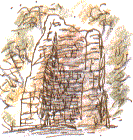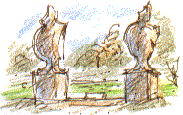Nature Diary
Rocks
History
Gallery
Links
Home Page
 LIKE THORNES PARK in Wakefield, the park at Thornhill has more history than its present municipal guise might suggest. The old Rectory, near the historic church, is now a residential home. Rectors of Thornhill included John Michell, the man who devised the experiment which was used to give the first accurate estimate of the weight of the Earth. Mitchell introduced William Herschel, then working as a musician in Huddersfield and Leeds, to astronomy. Herschel discovered Uranus in 1781.
LIKE THORNES PARK in Wakefield, the park at Thornhill has more history than its present municipal guise might suggest. The old Rectory, near the historic church, is now a residential home. Rectors of Thornhill included John Michell, the man who devised the experiment which was used to give the first accurate estimate of the weight of the Earth. Mitchell introduced William Herschel, then working as a musician in Huddersfield and Leeds, to astronomy. Herschel discovered Uranus in 1781.
 Another 18th century rector, John Mulso, was a friend of Gilbert White of Selborne, a pioneer of the nature diary. Unfortunately Mulso's surviving letters to White don't tell us much about the natural history of Thornhill, but they give an amusing glimpse of domestic life. He describes the produce of the gardens, including his success at growing a melons. In the old garden wall, constructed of handmade bricks there are flues which I suspect were an early form of greenhouse heating. Could they date back to Mulso's time?
Another 18th century rector, John Mulso, was a friend of Gilbert White of Selborne, a pioneer of the nature diary. Unfortunately Mulso's surviving letters to White don't tell us much about the natural history of Thornhill, but they give an amusing glimpse of domestic life. He describes the produce of the gardens, including his success at growing a melons. In the old garden wall, constructed of handmade bricks there are flues which I suspect were an early form of greenhouse heating. Could they date back to Mulso's time?
 Thornhill Hall was a ruin even in Mulso's time. After a Civil War siege in July 1648, during which the Parliamentarians cut of the supply of water to the house and set about draining the moat, the defenders of the hall had agreed to parley. But at six on the evening of the 22nd one of the defenders accidentally ignited their supply of gunpowder, killing four or five of the men, destroying part of the building and causing a fire which spread through the rest of the buildings. Only the chimney, the strongest part of the house still stands, alongside a few ruined walls.
Thornhill Hall was a ruin even in Mulso's time. After a Civil War siege in July 1648, during which the Parliamentarians cut of the supply of water to the house and set about draining the moat, the defenders of the hall had agreed to parley. But at six on the evening of the 22nd one of the defenders accidentally ignited their supply of gunpowder, killing four or five of the men, destroying part of the building and causing a fire which spread through the rest of the buildings. Only the chimney, the strongest part of the house still stands, alongside a few ruined walls.
 Worn statues known as Gog and Magog stand on the island. In legend Gog and Magog were giants defeated by Brutus, the founder of Britain. Their statues still stand on guard in the Guildhall, London.
Worn statues known as Gog and Magog stand on the island. In legend Gog and Magog were giants defeated by Brutus, the founder of Britain. Their statues still stand on guard in the Guildhall, London.
The Thornhill statues look more like griffins to me. They appear to carved from limestone, rather than local sandstone. The state of weathering on them and the style of the sculpture suggests the 17th or 18th century to me.

Richard Bell,
wildlife illustrator
E-mail; 'richard@daelnet.co.uk'
Next day
Previous day
Nature Diary
Wild West Yorkshire home page
|
 LIKE THORNES PARK in Wakefield, the park at Thornhill has more history than its present municipal guise might suggest. The old Rectory, near the historic church, is now a residential home. Rectors of Thornhill included John Michell, the man who devised the experiment which was used to give the first accurate estimate of the weight of the Earth. Mitchell introduced William Herschel, then working as a musician in Huddersfield and Leeds, to astronomy. Herschel discovered Uranus in 1781.
LIKE THORNES PARK in Wakefield, the park at Thornhill has more history than its present municipal guise might suggest. The old Rectory, near the historic church, is now a residential home. Rectors of Thornhill included John Michell, the man who devised the experiment which was used to give the first accurate estimate of the weight of the Earth. Mitchell introduced William Herschel, then working as a musician in Huddersfield and Leeds, to astronomy. Herschel discovered Uranus in 1781.
 Thornhill Hall was a ruin even in Mulso's time. After a Civil War siege in July 1648, during which the Parliamentarians cut of the supply of water to the house and set about draining the moat, the defenders of the hall had agreed to parley. But at six on the evening of the 22nd one of the defenders accidentally ignited their supply of gunpowder, killing four or five of the men, destroying part of the building and causing a fire which spread through the rest of the buildings. Only the chimney, the strongest part of the house still stands, alongside a few ruined walls.
Thornhill Hall was a ruin even in Mulso's time. After a Civil War siege in July 1648, during which the Parliamentarians cut of the supply of water to the house and set about draining the moat, the defenders of the hall had agreed to parley. But at six on the evening of the 22nd one of the defenders accidentally ignited their supply of gunpowder, killing four or five of the men, destroying part of the building and causing a fire which spread through the rest of the buildings. Only the chimney, the strongest part of the house still stands, alongside a few ruined walls. Worn statues known as Gog and Magog stand on the island. In legend Gog and Magog were giants defeated by Brutus, the founder of Britain. Their statues still stand on guard in the Guildhall, London.
Worn statues known as Gog and Magog stand on the island. In legend Gog and Magog were giants defeated by Brutus, the founder of Britain. Their statues still stand on guard in the Guildhall, London.